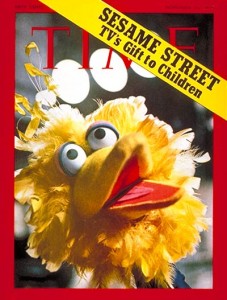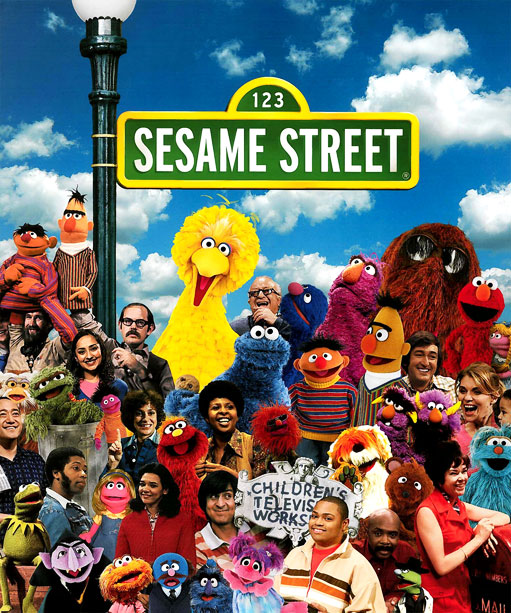Written by Leigh Kolb as part of our theme week on Children’s Television.
Until I was in kindergarten, the only channel I ever saw was PBS. For all I knew, it was the only channel that existed. I was an only child on a small farm, and in addition to the woods and barns, Sesame Street was my playground.
The diversity and multiculturalism that the show has prioritized since it debuted in 1969–45 years ago this year–not only exposed me to a world outside of my rural homogeneous upbringing, but it also certainly shaped who I would become.
Sesame Street‘s roots–as progressive, authentic, research-based, educational television for children–transformed the way generations saw television, education, and themselves.
With a background in education and journalism, Joan Ganz Cooney set out in 1967 to study how television could be used to educate children. Seeing a need for education–academic and social–she penned “The Potential Uses of Television in Preschool Education” after traveling the US and interviewing teachers, child psychologists, child development experts, and children’s TV producers. From the study, she created the Children’s Television Workshop to produce a “new kind of children’s program” (one whose format would be influenced by Rowan and Martin’s Laugh-In and commercials). She wanted to create a show that “would hold children’s interests, its characters would become their friends, and it would teach.”

Ganz Cooney’s resume and influence have made her an incredible force–she’s a woman whose name we should know. A self-described feminist and idealist, she was one of the first female television executives in America. She was CEO and chair of the Children’s Television Workshop until 1990, and continuously has served on nonprofit boards and worked toward literacy and education advancement for children.
So what does idealistic, feminist children’s television look like? It looks like Sesame Street, which over the course of its 45-year run has won more than 120 Emmy Awards. Sesame Street‘s frank and honest treatment of race, women’s rights, adoption, breastfeeding, death, childbirth, incarceration, divorce, HIV, health, bilingualism, and poverty throughout the years has added a dimension of social understanding to a show that also deals with teaching children their ABC’s and 123’s. A recent study showed that children who watched Sesame Street have GPA’s that are 16 percent higher than those who don’t; perform better in math, English, and science; read books for pleasure more often (and read better in kindergarten); and express “less aggressive attitudes.” Jim Henson’s Muppets and a cavalcade of guest stars over the years have helped make Sesame Street a popular, groundbreaking children’s television show.
Idealistic, feminist children’s television looks pretty good.

Of course, as a child of the 80s, I’m most familiar with the “classic” Sesame Street format and episodes. Recent years have shown growth with the times–a larger web presence, apps, streaming services, online games, and online activities have given Sesame Street a much larger network to educate and influence young minds. Over the last 45 years, Sesame Street has built an empire with the goal of not just entertaining children, but giving them a broader perspective on life and education.
Here are some highlights:
“Women Can Be”
[youtube_sc url=”https://www.youtube.com/watch?v=rpjmeyI2pfI”]
Buffy Sainte-Marie (who was a series regular in the late 70s and early 80s) Breastfeeding
[youtube_sc url=”https://www.youtube.com/watch?v=l2RwZW2j3-U”]
Roosevelt Franklin’s “The Skin I’m In”
[youtube_sc url=”https://www.youtube.com/watch?v=Ax2mf9IDvno”]
Nina Simone’s “To Be Young, Gifted and Black”
[youtube_sc url=”https://www.youtube.com/watch?v=I-f3PYJT5mU”]
“Goodbye, Mr. Hooper”
[youtube_sc url=”https://www.youtube.com/watch?v=gxlj4Tk83xQ”]
“I Love My Hair”
[youtube_sc url=”https://www.youtube.com/watch?v=1A-BHkoWV0g”]
Maya Angelou’s “My Name”
[youtube_sc url=”https://www.youtube.com/watch?v=GhTK0LM39ZU”]
Gordon’s “If I Had a Kid Like You” (Gordon and Susan would later adopt)
[youtube_sc url=”https://www.youtube.com/watch?v=rFzPXurun5M”]
“Change the World”
[youtube_sc url=”https://www.youtube.com/watch?v=DHOgHPBt8oQ”]
“Feeling Good/Feeling Bad”
[youtube_sc url=”https://www.youtube.com/watch?v=IgYiJWVf1EY”]
“I Love Every Part of You”
[youtube_sc url=”https://www.youtube.com/watch?v=as0rHfgeuvg”]
Sonia Sotomayor: “Princess is Not a Career”
[youtube_sc url=”https://www.youtube.com/watch?v=EHICz5MYxNQ&feature=player_embedded”]
“We All Sing the Same Song”
[youtube_sc url=”https://www.youtube.com/watch?v=MYXJlfcfFKU”]
I still am moved by the touching and transformative Sesame Street segments that powerfully show that we are both unique and not alone in this world. We need more of this kind of media for children (and for adults).
___________________________
Leigh Kolb is a composition, literature, and journalism instructor at a community college in rural Missouri.

3 thoughts on “Celebrating ‘Sesame Street’”
Comments are closed.